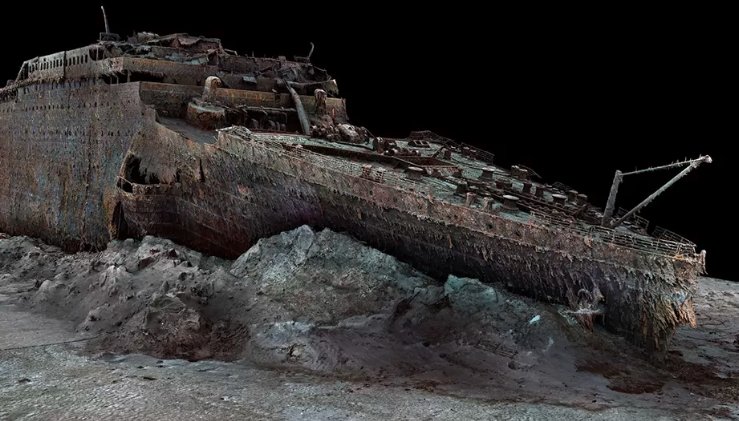A groundbreaking 3D scan of the RMS Titanic has exposed startling details of the ship’s last hours, confirming long-held theories and rewriting parts of its tragic history.
A wreck lost in darkness — until now
For over a century, the Titanic’s story has hovered in the space between history and legend. We’ve had eyewitness accounts, grainy sonar images, bits of debris brought to the surface — but never something like this.
That’s changed thanks to a 2022 underwater expedition that quietly captured over 700,000 high-resolution images, later stitched together to form the most accurate digital reconstruction of the Titanic ever made. Think of it as a “digital twin” — an exact 3D replica of the ship where it lies, nearly 13,000 feet below the surface of the North Atlantic.
It’s more than a tech marvel. It’s revealing things the ocean had hidden in silence for 113 years.

Engineers worked until the end — and the ship tells the story
The 3D model, created for the National Geographic documentary Titanic: The Digital Resurrection, gives researchers something they’ve never had before: a full, unobstructed view of the Titanic as it rests today. And what they’re seeing confirms some emotional truths.
Parks Stephenson, a leading Titanic historian who has visited the wreck twice, was stunned.
“One of the most striking things,” Stephenson said, “was seeing open steam valves still in place. That lines up exactly with survivor reports — the engineers never stopped trying to keep the power running.”
It’s eerie, really.
Just imagine — deep below, untouched for decades, these small but significant clues remained:
-
Valves opened intentionally
-
Machinery still positioned for use
-
Evidence of desperate attempts to buy passengers precious minutes
They died doing their jobs, and the ship has been whispering that truth all along.
A one-to-one model reveals the ship’s brutal disintegration
This wasn’t just about fancy imaging. It was about finally seeing the Titanic as it really is — torn, twisted, shattered, and yet still hauntingly recognizable.
What made this possible? Robotic camera drones operated by deep-sea specialists at Magellan Ltd. Working in near-total darkness, they captured every angle, every detail, every break. Then came the hard part: assembling it all into a precise replica — no guesses, no filler.
Stephenson explained that while he’d seen parts of the Titanic before, it was “like being in a pitch-black room with a weak flashlight.”
The replica changes that completely.
Here’s what stood out in the reconstruction:
-
The bow section remains surprisingly intact, still partially embedded in the seafloor
-
The stern is obliterated, resembling an explosion rather than a break
-
The debris field stretches wider than previously believed, reshaping theories on how the ship sank
The scale of destruction is sobering.
The digital twin could end decades of debate
Titanic experts have disagreed for decades on how the ship broke apart. Did it split cleanly in two? Did it corkscrew as it sank? Was it torn apart by pressure?
Thanks to the scan, that argument might finally have an answer.
Stephenson believes the data strongly supports the spiral theory — that as the ship’s stern lifted out of the water, the structure twisted violently before snapping and crashing down. The digital model shows a curved, chaotic debris field consistent with that motion.
Here’s a simplified look at the major theories and what the new scan supports:
| Sinking Theory | Previously Supported? | Confirmed by Scan? |
|---|---|---|
| Clean Break | Partially | No |
| Spiral Descent | Disputed | Strongly Yes |
| Hull Implosion from Pressure | Theorized | Inconclusive |
| Multiple Fragmentation Points | Yes | Yes |
That middle row is the key. The “spiral descent” idea has always been controversial. Now, it might just become the accepted truth.
Recreating history with chilling clarity
The project took over three weeks, but the payoff is immeasurable. It’s not just about the ship. It’s about the people. The frozen moment. The evidence left behind.
The replica shows things no human could see with the naked eye. From the collapsed grand staircase to subtle cracks in the metal, the ship has become a time capsule. And it’s speaking louder now than ever.
What makes this whole thing more emotional is that it’s not animated. It’s not simulated. It’s real — every angle of the ship exactly where it lies, untouched, undisturbed, and finally, fully visible.
“This isn’t just history,” said Stephenson. “It’s memory, frozen in steel.”
One sentence says more than all the archives.
A documentary, yes — but also a historical turning point
Atlantic Productions and National Geographic built the documentary not just as entertainment but as something closer to a digital archive. They’ve done this before — remember the Endurance wreck from Ernest Shackleton’s voyage? But this, this is different.
The Titanic isn’t just any shipwreck.
It’s a symbol. Of arrogance. Of grief. Of human error and selflessness all at once.
And now, in 2025, it’s been given new life — not in the poetic sense, but literally. A digital resurrection. The closest we’ve ever come to touching that night.
For researchers, this opens up entirely new ways to study maritime disasters. For families of victims, it may offer peace. For the rest of us, it’s simply haunting.














